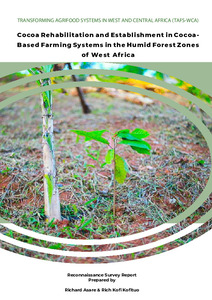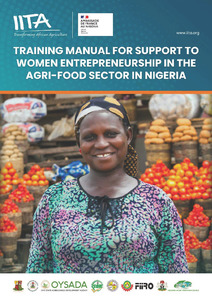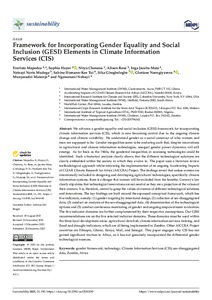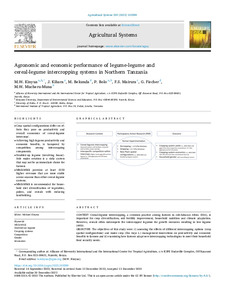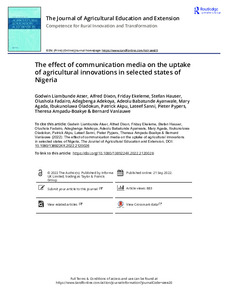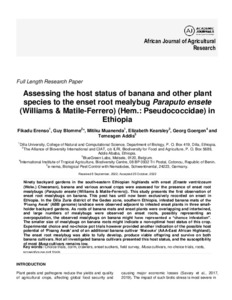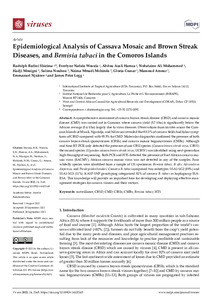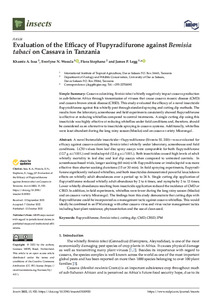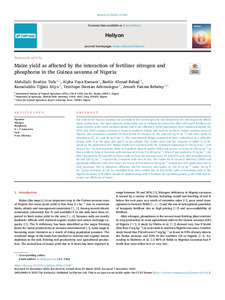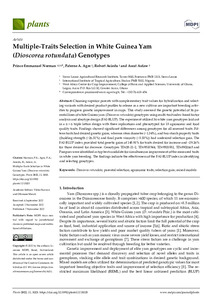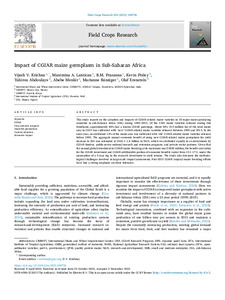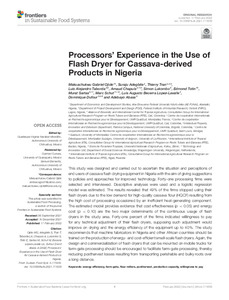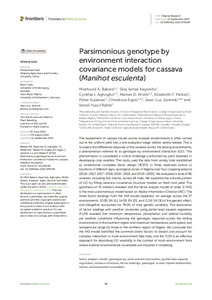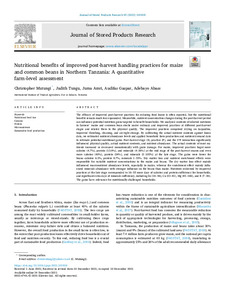Welcome to the International Institute of Tropical Agriculture Research Repository
IITA Bibliography System: Recent submissions
Now showing items 501-520 of 8094
-
Cocoa rehabilitation and establishment in cocoa-based farming systems in the humid forest zones of west Africa
(IInternational Institute of Tropical Agriculture, 2022)The cocoa rehabilitation and establishment in cocoa-based farming systems in the humid forest zones of West Africa is part of the larger TAFS-WCA initiative that seeks to enhance access to quality, nutrient-dense seed, and climate-smart good agricultural practices (GAP) and reduced post-harvest losses and to see how these have a positive impact on food and nutrition and health security. Within the cocoa sector in West Africa, this initiative seeks to improve yields of cocoa and food crops and ... -
Training manual for support to women entreprenueurship in the agri-food sector in Nigeria
(2022)The paradigm shifts from a supply-driven intervention to a more responsive demand-drive intervention necessitates the fulfillment of the sociological approach. This approach advocates that the needs of beneficiaries be ascertained before any intervention is carried out. Consequently, the training needs of women agri-preneurs were identified in Ibadan and Zaria of Oyo and Kaduna states, respectively during the inception of the Support to Women Entrepreneurship in the Agrifood sector in Nigeria ... -
Framework for Incorporating Gender Equality and Social Inclusion (GESI) elements in Climate Information Services (CIS)
(2023-01)We advance a gender equality and social inclusion (GESI) framework for incorporating climate information services (CIS), which is now becoming central due to the ongoing climate change and climate variability. We understand gender as a social construct of who women and men are supposed to be. Gender inequalities seem to be enduring such that, despite innovations in agricultural and climate information technologies, unequal gender power dynamics will still emerge. As far back as the 1960s, the ... -
Agronomic and economic performance of legume-legume and cereal-legume intercropping systems in Northern Tanzania
(2023-02)CONTEXT Cereal-legume intercropping, a common practice among farmers in sub-Saharan Africa (SSA), is important for crop diversification, soil fertility improvement, household nutrition and climate adaptation. However, cereals often outcompete the intercropped legumes for growth resources resulting in low legume yields. OBJECTIVE The objectives of this study were: i) assessing the effects of different intercropping options (crop spatial configurations) and maize crop (Zea mays L.) management ... -
The effect of communication media on the uptake of agricultural innovations in selected states of Nigeria
(2022-09-21)Purpose Poor uptake of agricultural innovations on weed management practices is a major factor responsible for low productivity. This paper examines how communication media can help improve farmers’ adoption behaviour. Methodology A sample of 725 Nigerian cassava farmers, exposed to agricultural innovation on weed management practices from varying sources, were asked, through a structured questionnaire, to indicate their knowledge, attitudes, and practices of cassava weed management. The responses ... -
The banana genome hub: a community database for genomics in the Musaceae
(2022-01-05)The Banana Genome Hub provides centralized access for genome assemblies, annotations, and the extensive related omics resources available for bananas and banana relatives. A series of tools and unique interfaces are implemented to harness the potential of genomics in bananas, leveraging the power of comparative analysis, while recognizing the differences between datasets. Besides effective genomic tools like BLAST and the JBrowse genome browser, additional interfaces enable advanced gene search ... -
Assessing the host status of banana and other plant species to the enset root mealybug Paraputo ensete (Williams & Matile-Ferrero)(Hem.: Pseudococcidae) in Ethiopia
(2022-12-01)Ninety backyard gardens in the south-eastern Ethiopian highlands with enset (Ensete ventricosum (Welw.) Cheesman), banana and various annual crops were assessed for the presence of enset root mealybugs (Paraputo ensete (Williams & Matile-Ferrero)). This study presents the first observation of enset root mealybugs on banana. This pest has until now been exclusively recorded on enset in Ethiopia. In the Dilla Zuria district of the Gedeo zone, southern Ethiopia, infested banana mats of the ‘Pisang ... -
Epidemiological analysis of Cassava Mosaic and Brown Streak Diseases, and Bemisia tabaci in the Comoros Islands
(2022-09-30)A comprehensive assessment of cassava brown streak disease (CBSD) and cassava mosaic disease (CMD) was carried out in Comoros where cassava yield (5.7 t/ha) is significantly below the African average (8.6 t/ha) largely due to virus diseases. Observations from 66 sites across the Comoros Islands of Mwali, Ngazidja, and Ndzwani revealed that 83.3% of cassava fields had foliar symptoms of CBSD compared with 95.5% for CMD. Molecular diagnostics confirmed the presence of both cassava brown streak ... -
Evaluation of the efficacy of Flupyradifurone against Bemisia tabaci on cassava in Tanzania
(2022-10-12)A novel butenolide insecticide—flupyradifurone (Sivanto SL 200)—was evaluated for efficacy against cassava-colonizing Bemisia tabaci whitefly under laboratory, screenhouse and field conditions. LC50 values from leaf disc spray assays were comparable for both flupyradifurone (12.7 g a.i/100 L) and imidacloprid (12.6 g a.i/100 L). Both insecticides caused high levels of adult whitefly mortality in leaf disc and leaf dip assays when compared to untreated controls. In screenhouse-based trials, longer ... -
Impact assessment of Striga resistant maize varieties and fertilizer use in Ghana: a panel analysis
(2022-11-06)This study analyzes the impact of a component of climate-smart agriculture (CSA) technology—Striga-resistant maize (SRM) varieties and mineral fertilizer—on maize yield and food security using two rounds of panel data in Ghana. The study employs a multinomial endogenous switching regression model and finds that joint adoption of SRM varieties and mineral fertilizer increased maize yield by 872 kg/ha, food consumption scores by 17, and consumption per adult equivalent unit by 38 kg/ha. The positive ... -
Predicting intercrop competition, facilitation, and productivity from simple functional traits
(2023-06-01)Context Recent meta-analyses demonstrate that intercropping can increase the land use efficiency of crop production by 20–30 % on average, indicating a strong potential contribution to sustainable intensification. However, there is substantial variability around this average: individual studies range from half to double the land productivity of monocrops. Legume-cereal intercrops and intercrops with high temporal niche separation tend to be more productive than the average, but these two combination ... -
Maize yield as affected by the interaction of fertilizer nitrogen and phosphorus in the Guinea savanna of Nigeria
(2022-11)The soils of the Nigeria savannas are particularly low in nitrogen (N) and phosphorus (P) and negatively affects maize productivity. The main objective of the study was to evaluate the interactive effect of N and P fertilizers on maize growth, grain yield, nitrogen uptake and N use efficiency. Field experiments were conducted during the 2015 and 2016 cropping seasons at Iburu in southern Guinea and Zaria in northern Guinea savanna zones of Nigeria. The treatments consisted of three levels of ... -
Multiple-traits selection in White Guinea Yam (Dioscorea rotundata) genotypes
(2022-11-07)Choosing superior parents with complementary trait values for hybridization and selecting variants with desired product profiles to release as a new cultivar are important breeding activities to progress genetic improvement in crops. This study assessed the genetic potential of 36 parental lines of white Guinea yam (Dioscorea rotundata) genotypes using multi-trait index-based factor analysis and ideotype design (FAI-BLUP). The experiment utilized 36 white yam genotypes laid out in a 6 × 6 triple ... -
Impact of CGIAR maize germplasm in sub-Saharan Africa
(2023-01)This study reports on the adoption and impacts of CGIAR-related maize varieties in 18 major maize-producing countries in sub-Saharan Africa (SSA) during 1995–2015. Of the 1345 maize varieties released during this timeframe, approximately 60% had a known CGIAR parentage. About 34% (9.5 million ha) of the total maize area in 2015 was cultivated with ’new’ CGIAR-related maize varieties released between 1995 and 2015. In the same year, an additional 13% of the maize area was cultivated with ’old’ ... -
Processors' experience in the use of flash dryer for cassava-derived products in Nigeria
(2022-02-17)This study was designed and carried out to ascertain the situation and perceptions of end users of cassava flash drying equipment in Nigeria with the aim of giving suggestions to policies and approaches for improved technology. Forty-one processing firms were selected and interviewed. Descriptive analyses were used and a logistic regression model was estimated. The results revealed that 49% of the firms stopped using their flash dryers due to the low demand for high-quality cassava flour (HQCF) ... -
Parsimonious genotype by environment interaction covariance models for cassava (Manihot esculenta)
(2022-09-21)The assessment of cassava clones across multiple environments is often carried out at the uniform yield trial, a late evaluation stage, before variety release. This is to assess the differential response of the varieties across the testing environments, a phenomenon referred to as genotype-by-environment interaction (GEI). This phenomenon is considered a critical challenge confronted by plant breeders in developing crop varieties. This study used the data from variety trials established as randomized ... -
Genetic variability and genotype by environment interaction of two major cassava processed products in multi-environments
(2022-10-17)Conversion of cassava (Manihot esculenta) roots to processed products such as gari and fufu before consumption is a common practice worldwide by cassava end-user for detoxification, prolonged shelf life or profitability. Fresh root and processed product yield are supposed to be equivalent for each genotype, however, that is not the case. Developing genotypes with high product conversion rate is an important breeding goal in cassava as it drives the adoption rates of new varieties. The objective ... -
Nutritional benefits of improved post-harvest handling practices for maize and common beans in Northern Tanzania: a quantitative farm-level assessment
(2022-01)The efficacy of improved post-harvest practices for reducing food losses is often reported, but the nutritional benefits remain much less expounded. Meanwhile, nutrient concentration changes during the post-harvest period can influence potential nutrition gains targeted to benefit households. We analyzed contents of selected nutrients in farmers’ maize and common bean stocks under ordinary and improved practices at different post-harvest stages and related them to the physical quality. The improved ... -
Evaluating the performance of lateral flow devices for total aflatoxins with special emphasis on their robustness under sub-Saharan conditions
(2021-10-20)As aflatoxins are a global risk for humans and animals, testing methods for rapid on-site screening are increasingly needed alongside the standard analytical laboratory tools. In the presented study, lateral flow devices (LFDs) for rapid total aflatoxin screening were thoroughly investigated with respect to their matrix effects, cross-reactivity, their performance under harsh conditions in Sub-Saharan Africa (SSA), and their stability, as well as when compared with liquid chromatography-tandem ...

